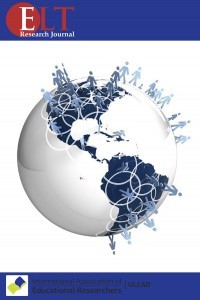Online Teaching and Learning: When Technology meets Language and Culture
Online Teaching and Learning: When Technology meets Language and Culture
online teaching and learning, educational technology, language and culture pedagogical implications,
___
- Arbaugh, J. B. (2004). Learning to learn online: A study of perceptual changes between multiple online course experiences. Internet and Higher Education, 7, 169-182.
- Garrison, D. R., Anderson, T., & Archer, W. (2000). Critical inquiry in a text-based environment: computer conferencing in higher education. The Internet and Higher Education, 2(2-3), 87-105.
- Hrastinski, S. (2009). A theory of online learning as online participation. Computers & Education, 52, 78-82.
- Jenkins, J. (2012). English as a Lingua Franca from the classroom to the classroom. ELT Journal, 66(4), 486-494.
- Kaufman, S. B., DeYoung, C. G., Gray, J. R., Jimenez, L., Brown, J., & Mackintosh, N. (2010). Implicit learning as an ability. Cognition, 116, 321-340.
- Ke, F. (2010). Examining online teaching, cognitive, and social presence for adult students. Computers & Education, 55, 808-820.
- Ke, F., & Xie, K. (2009). Toward deep learning for adult students in online courses. Internet and Higher Education, 12, 136-145.
- Kerr, M. S., Rynearson, K., & Kerr, M. C. (2006). Student characteristics for online learning success. Internet and Higher Education, 9, 91-105.
- Krish, P. (2008). Language learning in the virtual world: instructors' voices. International Journal of Pedagogies and Learning, 4(4), 113-129.
- Li, W., & Zhu, H. (2013). Translanguaging identities and ideologies: Creating transnational space through flexible multilingual practices amongst Chinese university students in the UK. Applied LInguistics, 34(5), 516-535.
- Mauranen, A. (2012). Exploring ELF: Academic English shaped by non-native speakers. Cambridge, New York: Cambridge University Press.
- Öztürk, K. (2012). Students' Perceptions of CALL at Dokuz Eylül University School of Foreign Languages. ELT Research Journal, 1(4), 216-229.
- Senior, R. M. (2006). The experience of language teaching. Cambridge: Cambridge University Press.
- Sharifian, F. (2013). Globalisation and developing metacultural competence in learning English as an International Language. Multilingual Education, 3(7), 1-11.
- Smith, G. G., & Kurthen, H. (2007). Front-stage and back-stage in hybrid E-learning face-to-face courses. International Journal on E-Learning, 6(3), 455-474. Reference.
- Yayın Aralığı: Yılda 2 Sayı
- Başlangıç: 2012
- Yayıncı: Uluslararası Eğitim Araştırmacıları Derneği
Online Teaching and Learning: When Technology meets Language and Culture
Interface between Language and Technology: Destabilising Standards
Social Networks as Practical Classrooms: A Study of Language Change and its Impact on ELT
Rajyashree KHUSHU LAHİRİ, Urjani CHAKRAVARTY
Students’ Perception on the Effectiveness of Mobile Learning in an Institutional Context
